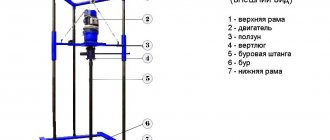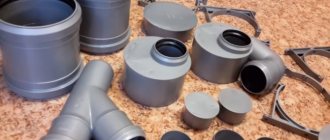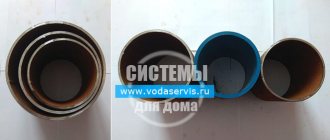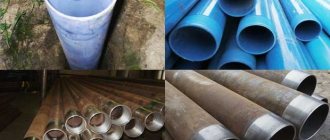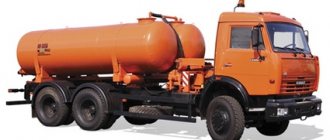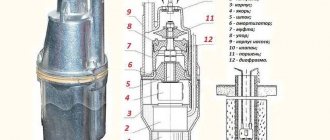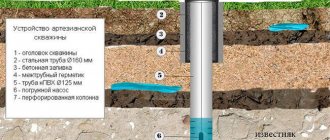Finding a good and inexpensive drilling rig for drilling water wells is not as easy as it might initially seem. In such a situation, this article will help you independently choose the best mechanism for your needs and wallet.
They come in the following types:
- self-propelled (various tractors and special equipment are used as chassis, for example MTZ, and cars of the following brands: ZIL, GAZ, UAZ, MAZ, as well as based on MKSM);
- small-sized MGBU (mounted on a tripod or frame, transported in a trailer or the back of a truck);
- with or without flushing;
- manual (connected to a regular walk-behind tractor);
- drums;
- homemade.
Self-propelled
The main advantage is considered to be that their movement does not require a truck, since they are made on the basis of a self-propelled chassis on tracks or wheels. Various tractors, all-terrain vehicles or trucks can be used as such a chassis.
Most often, a drilling unit is mounted on a chassis, with a hydraulic or mechanical drive; when using the latter, torque is transmitted to the auger from the engine of a car or all-terrain vehicle.
Among the positive qualities stand out:
- Exceptional mobility. The installation can work in any conditions, even in the field. The height of the tower can reach 5–7 meters, so work in the immediate vicinity of power lines may require a work permit.
- The drilling speed increases significantly due to the absence of the need to assemble and disassemble the mechanism, since the installation arrives at the site independently and is almost immediately ready for work.
- Self-propelled devices are easier to maintain and repair.
- Possibility of drilling mines up to 350 meters deep, at a speed of up to 10 m/h, depending on the hardness of the rock.
- Work on all types of soil. For high rock hardness, it is recommended to use drills made of high-strength steel or with diamond tips.
Percussion drilling
Used in loose and soft soils with pebbles, the rock is destroyed over the entire face area under the influence of drilling shell impacts. Impulses are transmitted by dropping a tool on cables into a well (cable-percussion method) or driving a drill attached to a rod (percussion-rod drilling). The first option is used more often. Projectile weight 0.5-2.5 tons, release height 0.3-1 m, frequency - 40-60 beats/min.
A driving tool is a pipe with a cutting edge or chisel attachment. The movement is initiated by a winch. The soil is held inside the cylinder due to friction forces.
The impact mechanism is a swinging frame driven by a crank structure, an eccentric, and hydraulic cylinders. For better crushing, water is added to the dry face. Drill cuttings are removed from the well after deepening every 20-60 cm.
Advantages of the impact method:
- possibility of drilling workings of large diameter;
- control of the aquifer level, elimination of contamination with sludge removal reagents;
- trouble-free use in winter;
- long service life of the water intake - up to 50 years.
Disadvantages of the impact method: labor intensity and low penetration speed. When the well is bent, difficulties arise with lowering the casing. To avoid difficulties, use a 2 m long drill.
MGBU
Because of their compactness, they are called small-sized, or, in short, MGBU. They were a real breakthrough. Thanks to MGBU, anyone can drill a well 70–100 meters, even those who have never encountered drilling work before.
These devices are divided into three types: mobile, collapsible and portable. They can be quickly disassembled, loaded into the back of a regular gazelle and brought to their destination. After delivery, the MGBU is easily unloaded, assembled and ready for use within 15–20 minutes.
An electric motor operating at 220 volts is most often used as a drive for small-sized devices.
For example, MGBU-70 weighs only 350 kilograms, but it is capable of drilling wells up to 70 m deep at a speed of 5–7 m/hour, depending on the hardness of the soil.
It does not require much space to operate, as the dimensions are only 115 x 120 x 270 cm.
Fittings, fittings and consumables for wells
To control water flows and connect different sections of the water supply system, fittings and shut-off valves are used.
- multi-entry fittings;
- corner fittings;
- tees;
- Ball Valves;
- couplings.
Fittings are selected in accordance with the diameter of the pipes used. Components made of polymer materials, stainless steel, bronze and brass are used. Fittings are used for wiring in the caisson and inside the house. They provide branching of the pipeline in two or more directions, bending the water supply at the desired angle. Using fittings, you can change from a pipe of one diameter to another. Compression fittings have O-rings and can withstand high pressure.
To work on the arrangement you will need consumables:
- check valve - ensures the movement of water in one direction. Installed between the membrane tank and the pump. The best place for installation is the place where the water riser pipe connects to the submersible pump;
- cable couplings – ensure the tightness of the electrical cable connection. Heat-shrinkable sleeves are used at the junction of the pump wire and the power cable;
- couplings with external and internal threads - necessary for connecting different sections of the water supply system.
The installation kit includes a plug for the hydraulic tank, elbows with different angles, bends, and tees. To work, you will need FUM tape, electrical tape, welding electrodes and cutting discs for an angle grinder.
Drilling with flushing
When using both small-sized devices and larger mechanisms, to increase the speed of rock passage, it is recommended to use drilling with flushing. This digging method allows you to increase the immersion speed to 10 m/hour, while the conventional dry method rarely allows you to reach a speed of more than 2 m/hour. There are two types of drilling with circulation, which are simply called direct and reverse methods.
Manual
There are also autonomous drilling devices created on the basis of a walk-behind tractor. They most often have a mechanical drive; it receives torque from the motor drill engine.
The small size of such devices allows you to work with them alone, and the use of a reduction gear allows you to drill wells of even large diameters. Their depth of penetration is much less than that of MGBU and self-propelled mechanisms, and the small size of such a manual drill allows you to make wells near the walls of buildings or fences.
If the aquifer on your site is at a depth of no more than 20–25 meters, then such a device would be an ideal solution for making an Abyssinian, and perhaps even an artesian well yourself. The drilling speed depends on the characteristics of the installed motor and is 3–5 m/hour. Due to their small size and low power, such installations are used on soft, peaty and clay soils.
Assembly of a small-sized drilling rig with manual drive
It is not difficult to make an auger installation for drilling a shallow well. The main element - the auger-drill - is made independently if you have the skill to work with a welding machine. You can buy ready-made screw sections or use an unnecessary ice drill. A T-shaped handle is attached to the top of the drill so that 2 people can rotate the tool.
Auxiliary equipment - a tripod mast, a hand crank with a rope for removing the auger drill - are made from scrap materials.
Self-assembly by hand.
Assembly is carried out in this order:
- a tripod of 3 logs, poles, metal pipes is installed above the well location point so that the rope block is at a height of 2.5-3 m from the ground;
- On one side of the tripod, a crank with a handle and a supply of cable Ø5-6 mm is mounted;
- The drill bit is placed at the drilling point.
The manually operated MGCU is ready for operation. After drilling the first 2 m, in order to maintain the vertical of the well, a conductor is placed in the excavation - a pipe with a diameter larger than the size of the drill. They drill to the aquifer.
Manufacturing of electric drilling rig
The mast for the MGBU with an electric drive is assembled from 3 metal poles Ø80 mm on a rectangular frame 120x140 cm in a vertical position with a 50 mm corner strap around the top of the posts. 2 supports are used as guides for a carriage with a geared motor or electric motor. The installation height of 2.5 m is the sum of the length of the drilling apparatus - 1.5 m - and 1 m is allocated to the height of the equipped slide and tackle.
On the side opposite to the rotator, a platform for a winch is attached to the stand, a block is hung, and the frame of the drilling rig is ready for operation. A projectile for destroying rock is selected based on the mining and geological conditions of the site.
Homemade
Drilling units are not only of the factory type. They can also be hand-made structures. Although it is worth immediately noting that the independent production of such a device can be justified only if it is used repeatedly or if you have most of the components, tools, welding equipment and a garage available.
If you want to build a drilling rig yourself, then you should pay attention to the simplest auger drill, as you can make it yourself in a few days. It is installed on a base to which guides are welded; an electric motor with a gearbox will rise and fall along them, and a drill will be attached to it using a swivel.
The procedure is as follows:
- You should start by purchasing materials to make bases, rods, and swivels. You also need to purchase a winch, an electric motor (2–2.5 kW) and a gearbox.
- Then the base should be made based on the engine power and gear ratio.
- Next you need to make a swivel and rods. These parts of the device must be purchased; you can order them from a mechanic, he will machine these parts with the required accuracy.
- Then you need to assemble the entire structure and prepare a place for mounting the electric motor.
- Only after this the engine and gearbox are mounted on the frame.
- Next, you need to secure the winch and connect its cable to the engine frame.
We draw conclusions about how to choose the right equipment for drilling wells
It should be noted right away that purchasing specialized expensive equipment is advisable if you are planning a professional activity. For one-time work, it is better to rent equipment or order it, when a team of drillers will perform all the necessary actions using their own equipment.
But if you want to drill a shallow well with your own hands, then the cheapest way is to assemble auger drilling equipment. The drill is taken from a fishing ice ax for holes. The handle is welded to it. When turning the auger manually, the main thing is to ensure that the hole for the casing pipes is level and vertical.
Features of the screw device
They are deservedly popular due to their high drilling speed, excellent functionality, ease of repair and maintenance and low cost of drilling operations. ShBUs are used in construction and utility organizations involved in the installation of communications and power lines. The disadvantages include the rather loud noise that is made during operation.
This unit is in most cases used as a machine for drilling wells in soft rocks, with a depth of no more than 120–150 meters. The waste soil is removed through the hole using a dry auger, although direct washing with water is also possible.
ShBU is irreplaceable:
- When constructing wells for water intake.
- When preparing holes for pile and grillage foundations.
- For communications in areas with high population density.
With the help of such units, not only vertical drilling is carried out, but also inclined, and the angle can be set arbitrarily.
INTERESTING! The auger passage of rock is characterized by increased well cleanliness, which is ensured by dry drilling. The absence of a flushing solution during operation allows the source to be put into operation much earlier. There is no need to wait for the water intake horizon to be cleared of the flushing solution, which is inevitable when drilling with flushing.
Hydraulic accumulator and automation system
The hydraulic accumulator is a steel tank with a membrane inside. The pump supplies water to the membrane tank, fills it and turns off. Water is supplied to water intake points from a hydraulic accumulator. When the level in the tank drops to a certain level, the pump turns on and fills the tank. The accumulator maintains a certain pressure, regulated by a relay. A decrease in pressure as water flows out of the tank turns on the pump.
The hydraulic accumulator is an important intermediate link between the well and the water intake point. The presence of a membrane tank allows you to turn on the pump less often, this reduces wear on the equipment and increases its service life. Hydraulic accumulators are produced with a volume of 20 to 200 liters. The larger the tank, the less often the pump turns on. Hydraulic accumulators are installed in a caisson or in a special room in the house. Membrane tanks are made of stainless steel and equipped with supports that reduce vibration during operation of the equipment.
The uninterrupted operation of the autonomous water supply system is ensured by automation, which includes:
- pressure switch;
- pressure gauge
The devices are designed to monitor and manage basic operating parameters and prevent water hammer.
The first generation automation is installed in the pipeline and adjusted manually. Hydraulic accumulators are produced equipped with an automation unit. Second generation devices are supplied as a single module and are controlled electronically. The microcontroller expands its capabilities; automation performs the following functions:
- turns off the system when the pressure level is exceeded;
- regulates operating parameters over a wide range of values;
- ensures smooth pump start;
- dampens water hammer;
- protects against repeated power switching on during leaks.
Electronic display makes monitoring parameters informative and simple.
In the third generation of automation for wells, the function of controlling the speed of rotation of the pump motor shaft is implemented. This ensures smooth water supply, stable pressure in the system, and energy savings.
Rotor system
These are underwater drilling rigs that drill rock using the method of continuous rotation of the working element - the rotor, on which the cutting bits are attached.
They are widely used due to their relatively small size and ability to work at great depths. In addition, the use of a rotor allows you to easily pass through hard rocks and even permafrost. Such a device will easily pass through limestone, marl, and permafrost soil.
Spent rock can be brought to the surface using one of the following methods:
- Using return water, it is pumped into the shaft under high pressure during the drilling process.
- Using a clay solution, fed through rods using the direct washing method.
- The conventional screw method is also often used.
IMPORTANT! The long-term performance of the drill is ensured by its constant cooling, which is achieved through the pumped aqueous solution.
Auger drilling
Used in light and loose sandy soils. Rocky and loose rocks are not amenable to this drilling method. The working body consists of a metal rod wrapped in a tape in the form of a spiral - an auger. The blades are used to carry destroyed soil to the wellhead. At one end the drill is equipped with steel or carbide cutters, at the other - with a device for connecting the next auger section.
An analogue of an auger machine is a fishing ice screw. The rotation of the drill string is carried out manually or using a motor drive.
Advantages of the method:
- the principle of operation is familiar to a wide range of summer residents, the use of an auger installation does not cause difficulties;
- a minimum number of projectile extractions helps speed up the construction of the water intake;
- low cost of driving 1 m of excavation;
- possibility of drilling in cramped conditions of a small area.
The inclusion of large boulders along the well route can lead to the cessation of drilling the well from the selected drilling location and a transition to another location.
The auger method has no other disadvantages, unless the method is used in rocks unusual for it.
How to choose drilling equipment
If you are thinking about the need to purchase a drilling unit, you should determine in advance the main parameters and requirements that you will place on it.
What parameters should you pay attention to:
- Drilling depth. In most cases, they give preference to small-sized equipment and do not overpay for increased power, which is needed only by geologists.
- Load capacity of the lifting mechanism. Based on this characteristic, three main types of drilling rigs can be distinguished: for creating hydrogeological wells, geological exploration of gas and oil, and in-depth exploration drilling.
- Ease of transportation can also play an important role in the choice. Consider whether you need an expensive self-propelled drilling rig or whether a small unit that fits in a regular trailer or truck bed will suffice.
Heating cable for pipeline
When building a water supply system for a house with a basement, the pipeline is inserted into the building below the freezing point of the soil. This guarantees protection against freezing of water in the pipes. In houses with strip foundations, the entrance to the building is above the freezing point. You can prevent a possible accident using a heating cable. It will maintain the temperature in the pipe above freezing. The cable is used underground and in the area where the water supply system is supplied to the house. The entire length of the pipeline can be protected. The temperature is maintained automatically, energy consumption is minimal.
Rent equipment
If purchasing such a unit is not practical for you due to the one-time nature of the work, then you should think about the possibility of renting or leasing a drilling device. Renting allows you to complete the task in the shortest possible time and at the same time save a significant amount. The fact is that the rental price also includes wages for the operator and his assistant, and thus you do not have to send your employees to work unusual for their profile.
The rental price of drilling equipment depends on many factors, including: the volume of work, duration of operation, location, number of workers servicing the system. On average, the cost of one shift starts from 2000–2500 thousand rubles.
Popular equipment for water wells MGBU in Russia
Equipment is classified into two categories:
- Lowerer (lifter) of drill strings. The work is carried out using a drilling derrick, a winch, and a pulley system.
- Drilling accessories and tools. These are rotors, a mud pump, swivels with drilling hoses, downhole motors and power drives.
All of the above can be purchased in Russia.
It is also possible to complete the complex. To do this, they buy a variety of cutters, sledgehammers, keys, cables, blocks and other little things that also cost money and need to be taken into account when drawing up estimates. Among the manufacturers of reliable, productive, unpretentious and durable equipment on the market you can find domestic and Western brands. Italian manufacturers have proven themselves well.
